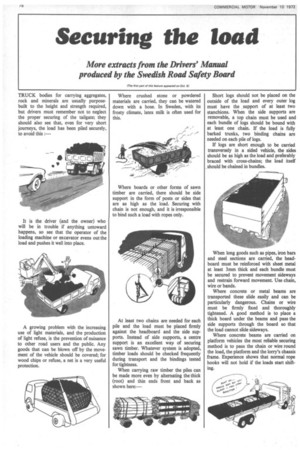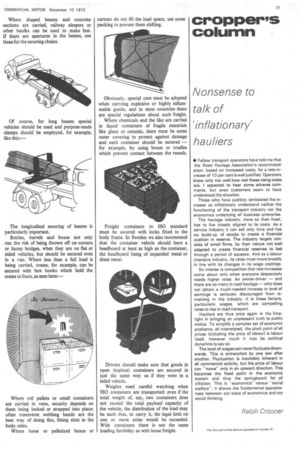Securing the load
Page 74

Page 75

If you've noticed an error in this article please click here to report it so we can fix it.
More extracts from the Drivers' Manual produced by the Swedish Road Safety Board
TRUCK bodies for carrying aggregates, rock and minerals are usually purposebuilt to the height and strength required, but drivers must remember not to neglect the proper securing of the tailgate; they should also see that, even for very short journeys, the load has been piled securely, to avoid this : ft is the driver (and the owner) who will be in trouble if anything untoward happens, so see that the operator of the loading machine or excavator evens out the load and pushes it well into place.
A growing problem with the increasing use of light materials, and the production of light refuse, is the prevention of nuisance to other road users and the public. Any goods that can be blown off by the movement of the vehicle should be covered; for wood chips or refuse, a net is a very useful protection. Where crushed stone or powdered materials are carried, they can be watered down with a hose. In Sweden, with its frosty climate, latex milk is often used for this.
Where boards or other forms of sawn timber are carried, there should be side support in the form of posts or sides that are as high as the load. Securing with chain is not enough, and it is irresponsible to bind such a load with ropes only.
At least two chains are needed for each pile and the load must be placed firmly against the headboard and the side supports. Instead of side supports, a centre support is an excellent way of securing sawn timber. Whatever system is adopted, timber loads should be checked frequently during transport and the bindings tested for tightness.
When carrying raw timber the piles can be made more even by alternating the thick (root) and thin ends front and back as shown here:— Short logs should not be placed on the outside of the load and every outer log must have the support of at least two stanchions. When the side supports are removable, a top chain must be used and each bundle of logs should be bound with at least one chain. If the load is fully barked trunks, two binding chains are needed on each pile of logs.
If logs are short enough to be carried transversely in a sided vehicle, the sides should be as high as the load and preferably braced with cross-chains; the load itself , should be chained in bundles.
When long goods such as pipes, iron bars and steel sections are carried, the headboard must be reinforced with sheet metal at least 3min thick and each bundle must be secured to prevent movement sideways and restrain forward movement. Use chain, wire or bands.
Where concrete or metal beams are transported these slide easily and can be particularly dangerous. Chains or wire must be firmly fixed and thoroughly tightened. A good method is to place a thick board under the beams and pass the side supports through the board so that the load cannot slide sideways.
Where concrete beams are carried on platform vehicles the most reliable securing method is to pass the chain or wire round the load, the platform and the lorry's chassis frame. Experience shows that normal rope hooks will not hold if the loads start shifting. Where shaped beams and concrete sections are carried, railway sleepers or other baulks can be used to make fast. If there are apertures in the beams, use these for the securing chains.
Of course, for long beams special vehicles should be used and purpose-made clamps should be employed, for example, like this:—
The longitudinal securing of beams is particularly important.
Bottles, barrels and boxes not only run the risk of being thrown off on' corners or hump bridges, when they are on flat or sided vehicles, but should be secured even in a van. Where less than a full load is being carried, crates, for example, can be secured with box hooks which hold the crates in fours, as seen here:—
Where roll pallets or small containers are carried in vans, security depends on them being locked or strapped into place; often transverse webbing bands are the best way of doing this, fitting slots in the body sides.
Where loose or palletized boxes or cartons do not fill the load space, use some packing to prevent them shifting.
Obviously, special care must be adopted when carrying explosive or highly inflammable goods, and in most countries there are special regulations about such freight.
Where chemicals and the like are carried in liquid containers of fragile materials like glass or ceramic, there must be some outer covering to protect against damage and each container should be secured — for example, by using boxes or cradles which prevent contact between the vessels.
Freight containers to ISO standard must be secured with locks fitted to the body frame. In Sweden we also recommend that the container vehicle should have a headboard at least as high as the container, the headboard being of expanded metal or sheet metal.
Drivers should make sure that goods in open (topless) containers are secured in just the same way as if they were in a sided vehicle.
Weights need careful watching when ISO containers are transported: even if the total weight of, say, two containers does not exceed the total payload capacity of the vehicle, the distribution of the load may be such that, to carry it, the legal limit on one or more axles would be exceeded. With containers there is not the same loading flexibility as with loose freight.




































































































































